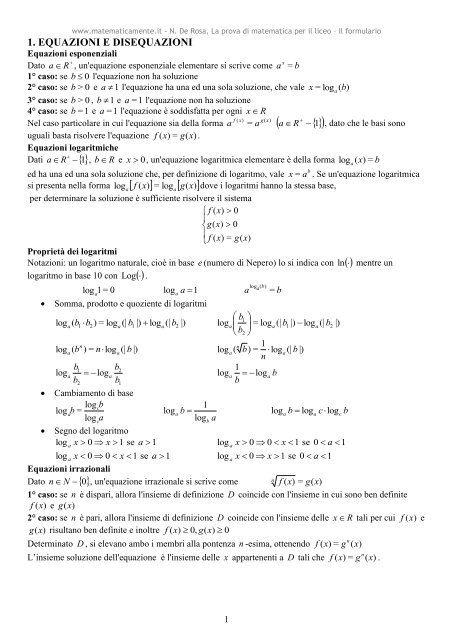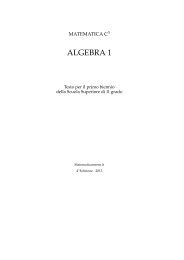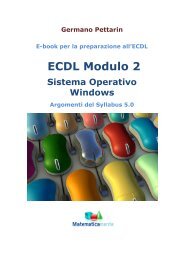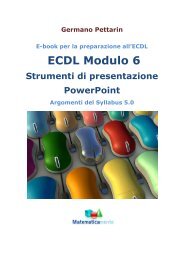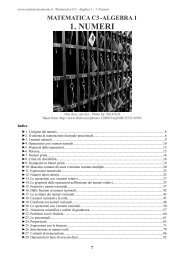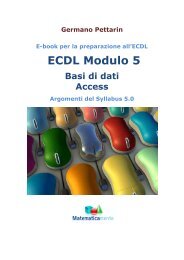Formulario completo di matematica - shop - Matematicamente.it
Formulario completo di matematica - shop - Matematicamente.it
Formulario completo di matematica - shop - Matematicamente.it
- No tags were found...
You also want an ePaper? Increase the reach of your titles
YUMPU automatically turns print PDFs into web optimized ePapers that Google loves.
www.<strong>matematica</strong>mente.<strong>it</strong> - N. De Rosa, La prova <strong>di</strong> <strong>matematica</strong> per il liceo – Il formulario2. GEOMETRIA ANALITICA NEL PIANORettaEquazione in forma implic<strong>it</strong>a ax by c = 0Equazione in forma esplic<strong>it</strong>a y = mx qRelazione tra i coefficientia cm = , q = e b 0 .b bm si <strong>di</strong>ce coefficiente angolare o pendenza, q si <strong>di</strong>ce intercetta o quota.Retta parallela all'asse x y = k Retta parallela all'asse y x = h Retta passante per due punti A = x1,y1 e B = x2,y2x x1 y y1=x2 x1 y2 y1 Coefficiente angolare <strong>di</strong> una retta passante per due puntiy1 y2m =x1 x2se x1 x2 Con<strong>di</strong>zione <strong>di</strong> parallelismo:tra le rette ax by c = 0 e a'x b'y c'=0 a b' b a'= 0 .tra le rette y = mxq e y = m'x q'm = m' Con<strong>di</strong>zione <strong>di</strong> perpen<strong>di</strong>colar<strong>it</strong>à:forma implic<strong>it</strong>a a a' bb'=0 forma esplic<strong>it</strong>a m m' = 1. Fascio improprio <strong>di</strong> rette:Se la retta data è ax by c = 0 il fascio è ax by k = 0Se la retta data è y = mxq il fascio è y = mx k Fascio proprio <strong>di</strong> retteSe ax by c = 0 e a'x b'y c'=0 si intersecano in P( x0, y0)l'equazione del fascio proprio è h( ax by c) k(a'x b'y c')= 0hposto = si hak ( ax by c) a'x b'y c'=0al variare <strong>di</strong> R si hanno tutte le rette del piano passanti per P , ad eccezione <strong>di</strong> ax by c = 0 .| ax by0 cDistanza punto-retta: dato P( x0, y0)e la retta ax by c = 0 , la <strong>di</strong>stanza è d =2 2a bCirconferenzaEquazione della circonferenza <strong>di</strong> centro ( , )e raggio R22 2( x ) ( y )= R0|2 22 2a b a b L'equazione x y ax by c = 0 , se c 0 , rappresenta la circonferenza <strong>di</strong> centro , 4 4 2 2 e raggio2 2a b 1 2 2R = c = a b 4c4 4 2Circonferenze con centro nell'origine2x 2 2Circonferenze passanti per l'origine x y ax by= 0 Fasci <strong>di</strong> circonferenze:22Circonferenze concentriche <strong>di</strong> centro ( , )( x ) ( y )= ky22 22 2Date le circonferenze x y ax by c = 0 e x y a x b y c = 0 , l’equazione del fascio è= R2 22 2x y ax by cx y a x b y c = 0, 01 1 12 22 2posto 0 , t si ha x y ax by ctx y a1x b1y c1= 0, t 1che rappresenta una circonferenza tranne per t 1, caso in cui la circonferenza degenera in una retta.Se a a1 b b1; se a a1 b b1le due circonferenze sono concentriche e l’equazione del fasciodegenera in un numero (polinomio <strong>di</strong> grado zero in x e y).321112
www.<strong>matematica</strong>mente.<strong>it</strong> - N. De Rosa, La prova <strong>di</strong> <strong>matematica</strong> per il liceo – Il formulario Asse ra<strong>di</strong>cale <strong>di</strong> una circonferenzaè la retta che si ottiene imponendo t 1nel fascio <strong>di</strong> circonferenza <strong>di</strong> equazione2 22 2x y ax by ctx y a1x b1y c1=0 nel caso in cui a a1 b b1, ed è perpen<strong>di</strong>colarealla retta che congiunge i centri delle circonferenze stesse: a a1 x b b1y c c1 0Se le due circonferenze si intersecano in A e B, punti base del fascio, l’asse ra<strong>di</strong>cale è la retta AB.Se le due circonferenze sono tangenti l’asse ra<strong>di</strong>cale è la retta passante per T e ivi tangente ad ognicirconferenza del fascio.x , y , x , y , x y Circonferenza passante per tre punti xxdetxx1231 1 2 2 3,yyyy123xxxx2212223 y y y y2212223131 01ParabolaLa parabola è il luogo dei punti del piano equi<strong>di</strong>stanti da un punto fisso detto fuoco e da una retta fissa detta<strong>di</strong>rettrice. Parabola con asse <strong>di</strong> simmetria parallelo all'asse yEquazioneFuocoF = 22y = ax bx c con a, b,c R e a 0 .ba21b 4ac ,4a<strong>di</strong>rettrice11by =4a2 4ac2bAsse <strong>di</strong> simmetria x = 2avertice b b 4ac V =, 2a4aConcav<strong>it</strong>à:se a 0 la parabola ha concav<strong>it</strong>à verso l'alto, si <strong>di</strong>ce convessa, ha minimo nel vertice;se a 0 la parabola ha concav<strong>it</strong>à verso il basso, si <strong>di</strong>ce concava, ha massimo nel vertice. Parabola con asse <strong>di</strong> simmetria parallelo all'asse x2Equazione x = ay by c con a, b,c R e a 0 .21b 4acbFuoco 1b2 4acF = , <strong>di</strong>rettrice x = 4a2a4a2bAsse <strong>di</strong> simmetria y = 2avertice b 4acb V = , 4a2aConcav<strong>it</strong>à: se a 0 concav<strong>it</strong>à verso destra, se a 0 concav<strong>it</strong>à verso sinistra.EllisseUn'ellisse è il luogo dei punti del piano per i quali è costante la somma delle <strong>di</strong>stanze da due punti fissi dettifuochi. Equazione canonica: x 2 2y = 1 dove 2 2a ,b > 0a bSe a b l'asse focale è parallelo all'asse x , se a b l'asse focale è parallelo all'asse y .Se a = b si ottiene l'equazione <strong>di</strong> una circonferenza con centro nell'origine e raggio a .22Equazione dell'ellisse traslata rispetto al punto ( x 0,y ( x x0)( y y0)0) = 1 .22a bx= a cos( t) x0Equazione parametrica , t [0,2)=bsin(t) x02 2x yData un'ellisse <strong>di</strong> equazione = 12 2 , le coor<strong>di</strong>nate dei vertici sonoa bVertici: A = ( ,0) A = ( ,0) B = (0, ) B = (0, )1a2a1b2b4
www.<strong>matematica</strong>mente.<strong>it</strong> - N. De Rosa, La prova <strong>di</strong> <strong>matematica</strong> per il liceo – Il formulariobAsintoti: y = xaAsse focale:se a b l’asse focale è A 1A2, l’asse minore è B 1B2se a b l’asse focale è B 1B2l'asse minore è A 1A2se a > b la lunghezza dell'asse focale è 2 ase a b la lunghezza dell'asse focale è 2 bFuochi2 2Posto c = | a b | , le coor<strong>di</strong>nate dei fuochi sonose a b F1= ( c,0)F2 = ( c,0)se a b F1= (0, c)F2 = (0, c)Eccentric<strong>it</strong>àData un'ellisse <strong>di</strong> equazione x 2 2y , e posto 2 2 = |2 2c a b |a bcse a b l'eccentric<strong>it</strong>à vale e = ,acse a b l'eccentric<strong>it</strong>à vale e =bSe a , b 0 , con a b , risulta 0 e 1. Se a = b , ossia per la circonferenza, risulta e = 0 .IperboleL'iperbole è il luogo dei punti del piano per cui è costante la <strong>di</strong>fferenza delle <strong>di</strong>stanze da due punti fissi dettifuochi.2 2x yIperbole con i fuochi sull'asse x e simmetrici rispetto all'origine = 12 2 cona, b R .a b2 2x yIperbole con i fuochi sull'asse y e simmetrici rispetto all'origine = 12 b2a sin( t)x= a cosh( t)x = acos( t)3Equazione parametrica , t [0,2) o , t [0,2) \ , y= bsinh(t) b 2 2y =cos( t)Vertici:2 2x yse = 12 2 i vertici sono A1 = ( a ,0) A2 = ( a,0)a b2 2x yse = 1i vertici sono B = (0, )2 b21b B2 = (0, b)abAsintoti: y = xa2 2Fuochi: posto c 2 = a bse appartenenti all’asse x hanno coor<strong>di</strong>nate F1= ( c,0)F2 = ( c,0)se appartenenti all’asse y hanno coor<strong>di</strong>nate F1= (0, c)F2 = (0, c)Eccentric<strong>it</strong>àcSe i fuochi appartengono all'asse x l'eccentric<strong>it</strong>à vale e =acSe i fuochi appartengono all'asse y l'eccentric<strong>it</strong>à vale e = .b Iperbole equilatera5
SeSewww.<strong>matematica</strong>mente.<strong>it</strong> - N. De Rosa, La prova <strong>di</strong> <strong>matematica</strong> per il liceo – Il formulario2 2 2a = b e i fuochi appartengono all'asse x l'iperbole equilatera è x y = aa = b e i fuochi appartengono all'asse y l'iperbole equilatera èx2 y2= aGli asintoti <strong>di</strong> un'iperbole equilatera sono y = x e y = x, l’'eccentric<strong>it</strong>à è e = 2 . Iperbole equilatera rifer<strong>it</strong>a agli assiUn'iperbole equilatera ruotata <strong>di</strong> 45 ha per asintoti gli assi cartesiani, l’equazione è xy = k Funzione omograficaUna funzione omografica è un'iperbole equilatera con asintoti paralleli agli assi cartesiani, ma nonnecessariamente coincidenti con gli assi stessi.ax bDati a, b,c,d R , con c 0, l'equazione <strong>di</strong> una funzione omografica è y =cx ddSe ad bc = 0 l'equazione è una retta parallela all'asse x privata del punto <strong>di</strong> ascissa c d a Se ad bc 0 l'equazione rappresenta un'iperbole equilatera con centro <strong>di</strong> simmetria , e asintoti c c d ax = e y = .c cAltri luoghi e proprietà 1 2 1 2 Punto me<strong>di</strong>o <strong>di</strong> un segmento AB: se A( x1, y1)e B( x2, y2)il punto me<strong>di</strong>o è x x ,y My 2 2 . Distanza fra due punti (lunghezza <strong>di</strong> un segmento)Se A ( x 1, y ) e B ( x 2, y ) la lunghezza <strong>di</strong> AB è=1=2d = ( x x y221) ( y 2) Asse <strong>di</strong> un segmento AB2 2 2 2Se A = ( x 1, y1)e B = ( x 2, y2)l’asse è 2( x1 x2)x 2( y1 y2)y (x1 x2) (y1 y2) = 0 BisettriceDue rette <strong>di</strong>stinte a1x b1y c1= 0 e a2x b2y c2= 0 in<strong>di</strong>viduano nel piano quattro angoli, le cui bisettricia1 x b1y c1a2x b2y c2a1 x b1y c1a2x b2y c2sono== 2 22 22 22 2a b a ba b a b1122 Luogo dei punti a <strong>di</strong>stanza assegnata da una rettaIl luogo dei punti a <strong>di</strong>stanza d dalla retta ax by c = 0 è dato dalle due rette <strong>di</strong> equazione2 22 2ax by c d a b = 0 ax by c d a b = 0 Baricentro <strong>di</strong> un triangoloDato un triangolo <strong>di</strong> vertici in A ( x 1, y ), B ( x 2, y ) , C ( x 3, y ) ,le coor<strong>di</strong>nate del baricentro sono=1G =x=2=31 x2 x3y1 y2 y33,113222 Area <strong>di</strong> un triangoloSe i vertici del triangolo sono A ( x 1, y ), B ( x 2, y ) , C ( x 3, y )=1=2=3 x1y111 1la sua area vale Area = detx2y21= x1y2 x3y1 x2y3 x3y2 x1y3 x2y12 2x3y31 6
www.<strong>matematica</strong>mente.<strong>it</strong> - N. De Rosa, La prova <strong>di</strong> <strong>matematica</strong> per il liceo – Il formularioTrasformazioni geometricheX x aTraslazioni nel piano Y= y bRotazioni nel piano <strong>di</strong> centro O in senso antiorario <strong>di</strong> un angolo X= xcos ysincos sin22con cos sin 1 0Y= xsin y cossincosRototraslazioni nel piano <strong>di</strong> centro C a, bin senso antiorario <strong>di</strong> un angolo Xxcos ysin a a cos bsincos sin2con cos sinY= xsin y cos b asin bcossincosX ax by m a bAffin<strong>it</strong>à con ad cb 0Y= cx dy nc dX ax by m a b2 2Simil<strong>it</strong>u<strong>di</strong>ne <strong>di</strong>retta con a b 0Y= bx ay nb aX ax by m a b2 2Simil<strong>it</strong>u<strong>di</strong>ne in<strong>di</strong>retta con a b 0Y= bx ay nb a=2Il numero k 2 2a b è detto rapporto <strong>di</strong> simil<strong>it</strong>u<strong>di</strong>ne.X ax by ma b2 2Isometria <strong>di</strong>retta con a b 1Y= bx ay nb aX ax by m a b2 2con a bY= bx ay nb a X kx k 0Omotetia <strong>di</strong> centro O e rapporto k con k2 0Y= ky 0 kDilatazione <strong>di</strong> centro OX kxY= hycon h,k 0Simmetria rispetto all’asse delle ascisseX xY ySimmetria rispetto all’asse delle or<strong>di</strong>nateX xY yX xSimmetria rispetto alla retta y k è Y y 2kX x 2hSimmetria rispetto alla retta x h è Y yX ySimmetria rispetto alla bisettrice del 1° e 3° quadrante Y xX ySimmetria rispetto alla bisettrice del 2° e 4° quadrante Y xSimmetria rispetto all’origineX xY yX x 2aSimmetria rispetto al punto C a, bè Y y 2bIsometria in<strong>di</strong>retta 1 1 07
www.<strong>matematica</strong>mente.<strong>it</strong> - N. De Rosa, La prova <strong>di</strong> <strong>matematica</strong> per il liceo – Il formulario3. GONIOMETRIA E TRIGONOMETRIA2sin 2 Prima relazione fondamentale cos 1Con sin 21cos ,cos 21sin Secondasintan , k, k Zcos 2 Terzacos 1 cot , k, k Z oppure cot , k , k Zsintan2 Quarta1 sec , k, k Zcos 2 Quinta1cosec , k, k Zsin Archi associaticos = cos sin = sin tan = tancos = cos = sin tan = tan sin cos 2 2 2 cos = sin sin = cos tan = cot 2 2 2 Formule <strong>di</strong> ad<strong>di</strong>zione e sottrazionesin sincos cos sin cos cos cos sinsintan tan tan , ,, , k, k Z1tantan 2cot cot 1cot , ,, , k, k Zcot cot Formule per la duplicazione22222 2sincos cos 2 cos sin 12sin 2cos 2tan tan2 , k, k , k Z21tan 2 4 22cot 1cot2 , k , k Z2cot 2 Formule <strong>di</strong> triplicazione33sin3 = 3sin 4sin cos3 = 4cos 3cos33tan tan tan 3=, k , k Z213tan 6 3 Formule per la bisezione 1cos 1cossin cos 2 22 2 = sin sin = cos tan = cot sin 1 1costan , 2 1cos Formule parametriche2 tansin 2, 2k1 ,2 1tan22k1, k Z 1coscot , 2k,2 1cos1tan k Z cos , 2k1, k Z1tan2222k Z8
www.<strong>matematica</strong>mente.<strong>it</strong> - N. De Rosa, La prova <strong>di</strong> <strong>matematica</strong> per il liceo – Il formulario2 2 tan1tan2 tan , k, k Z tan2, k, k Z2 21tan2 tan22 Formule <strong>di</strong> prostaferesi sin sin 2sincos sin sin 2cossin 2 2 2 2 cos cos 2coscos cos cos 2sinsin 2 2 2 2 sin sintan tan , , k, k Z cot cot , , k, k Zcoscos 2sinsin Formule <strong>di</strong> Werner11sin cos sin sin cos cos scos in cos 221sin sin cos cos 2 Formule <strong>di</strong> Briggsa b cSiano a,b,c,p la lunghezza dei tre lati ed il semiperimetro <strong>di</strong> un triangolo. Si ha:2 p b p c pp asin 2 sin 2 sin 2tantantanbcp a p cacp a p babcos 2 cos 2 cos 2bcp p cabp p bac p b p c pp acot2 pp a 2 p b p c p a p c pp bcot2 pp b 2 p a p c p a p b p p ccot 2 pp c 2 p a p bConversione fra ra<strong>di</strong>anti e gra<strong>di</strong> misura in ra<strong>di</strong>anti, misura in gra<strong>di</strong>: 180 = = 1809
www.<strong>matematica</strong>mente.<strong>it</strong> - N. De Rosa, La prova <strong>di</strong> <strong>matematica</strong> per il liceo – Il formulario Archi notevoli (ra<strong>di</strong>anti) (gra<strong>di</strong>)012108654310338255122sin cos tan cot 0 0 1 0 non esiste151822 30306 45 142 2121436 10 2 545546067 30225 14322 272 10 2 575146 42222146 4210 22 232145 142212210 22 25 146 422552 3 2 35 2555 22 1 2 1335 251 15 253535 255 2332 1 2 15 255 252 3 2 390 1 0 non esiste 0555510
www.<strong>matematica</strong>mente.<strong>it</strong> - N. De Rosa, La prova <strong>di</strong> <strong>matematica</strong> per il liceo – Il formularioTriangolo rettangolob = asin = acos,c = asin( ) = acosb = c tan = ccot , c = btan = bcot Teorema della cordaSia R il raggio della circonferenza, e sia l'ampiezza dell'angolo allacirconferenza sotteso dalla corda AB , allora la lunghezza <strong>di</strong> AB èAB = 2Rsin()Triangolo qualsiasi Area del triangolo1 1 1A = absin = bcsin = acsin2 2 22 sinsin 1 2 sinsin 1oppure A a b c2 sin 2 sin 21 2 sinsinsina b cTeorema dei seni = =sin sin sinTeorema del coseno (o <strong>di</strong> Carnot)2 2 22 2 22 2 2a = b c 2bccos b = a c 2accos c = a b 2abcosTeorema delle proiezioni a = bcos ccos b = acos ccos c = acosbcosRaggio della circonferenza inscr<strong>it</strong>ta in un triangolo <strong>di</strong> area A e semiperimetro pA r = = p atan = p btan = p ctanp 2 2 2 a b cRaggio della circonferenza circoscr<strong>it</strong>ta a un triangolo R = = =2sinRaggio della circonferenza exinscr<strong>it</strong>ta tangente, rispettivamente, ai lati <strong>di</strong> misura a , b , c :r = A arb = A rc=Ap a p b p cabc= 2sin 2sin 4ALunghezza della me<strong>di</strong>ana relativa, rispettivamente, ai lati <strong>di</strong> misura a , b , c :1 2 2 2 1 2 2 2 1 2 2m a= 2b 2c a m b= 2a 2cbm c= 2a 2b c222Lunghezza della bisettrice relativa, rispettivamente, agli angoli <strong>di</strong> ampiezza , , : 2bccos2accos2abcosb 2=b 2=b 2 =b ca ca b tan cota bTeorema delle tangenti o <strong>di</strong> Nepero 2 2a b tan tan 2 2 Significato trigonometrico della pendenza <strong>di</strong> una rettam coefficiente angolare della retta e misura dell’angolo tra retta e asse delle ascisse: m tanAngolo tra due rettem m'm ,m' coefficienti angolari delle rette, misura dell’angolo tra le rette. Si ha tan1mm'211
Coor<strong>di</strong>nate polariwww.<strong>matematica</strong>mente.<strong>it</strong> - N. De Rosa, La prova <strong>di</strong> <strong>matematica</strong> per il liceo – Il formulariox cos, , : y sin xy2 2 x y y arctan se x0 e y0x y arctan 2 se x 0 e y 0 x , , : y arctan se x 0 x se x0 e y 0 2 3 se x0 e y02 xy 12
4. ANALISILim<strong>it</strong>iwww.<strong>matematica</strong>mente.<strong>it</strong> - N. De Rosa, La prova <strong>di</strong> <strong>matematica</strong> per il liceo – Il formularioProprietà dei lim<strong>it</strong>iSe lim f ( x)= l R e lim g(x)= l R , alloraSeSeSexx0xx01xx0lim f ( x)= l1, Rxx0lim 1 1= , l 0xxf ( x)l10lim f ( x)= l R exx0xx01lim g(x)= , alloraxx0lim f ( x) g(x)= lim f ( x)= lim g(x)= , alloraxx0xx0lim f ( x) g(x)= lim f ( x)= l R /xx00e2lim f ( x) g(x)= lxx0f ( x)l1lim = , l2 0xxg(x)l0xx021 llim f ( x) g(x)= lim f ( x) g(x)= xx0lim g(x)= , alloraxx02lim f ( x) g(x)= l lxx0 se l > 0f ( x)lim f ( x) g(x)= lim = 0xx0 se l < 0xx0 g(x)Se lim f ( x)non esiste, ma f (x)è una funzione lim<strong>it</strong>ata, e se lim g(x)= 0 , alloraxx0lim f ( x) g(x)= 0xx0Se lim f ( x)xx0xx0xx0non esiste, ma f (x)è una funzione lim<strong>it</strong>ata, e se lim g(x) lim f ( x) g(x)= xx0f ( x)lim = 0g()xx0 x, allora1213
www.<strong>matematica</strong>mente.<strong>it</strong> - N. De Rosa, La prova <strong>di</strong> <strong>matematica</strong> per il liceo – Il formularioTavola dei lim<strong>it</strong>i notevoli Razionalinn1anx an1x a0lim=mm1xb x b x bmm1 0an an an se n m e 0; se n m e 0; se n m; 0 se n mbm bm bmEsponenziali e logar<strong>it</strong>mici 1lim 1 xx xx ea lim 1 x xx ex 11 lim lim 1 ax x exx 1ex0loga1 x1lim logae a Rx0xln aa x 1lim ln a,a R / 10xxlim log x a (1,)x0alim logxax aa/ 114a lim 1 x xln 1xlimx0xbx e 1ab11lim ax0xe x 1lim 1x0 xlim log x a 0,1x0 a (1,)lim logaaxlim a xxlim a xxlim x bxx ax a xlim a 1 0 a (1,)x0lim a xxlim a xxlim x bxx0 a 0 a 0,10,1 b 0, logaxlim a rxb xxlim x a = lim a , b Rxxxxaxlim = lim a , b Rbx xx blim e x = 0, b Rx0,1 , r R, a R, a R/ 1/ 1 Goniometrici e iperbolicisin xsin mx mlim 1lim x0xx0nx ntan xtan mx mlim 1lim x0xx0nx narctan xarctan mxlim 1 lim x0xx0nxx sin x 1tanh xlim lim 1x03x 6x0xlimx2tan x lim cot x x0lim tan x x2mnlim xx0xr a (1,) 0logab ,0x 0x a R0,11 ,/ r Rlogaxlim a (1,), r Rx0rxb xxlim | x | a = lim a , b Rlimxxabx= lim ax1cos xlim 00xarcsin xlim 1x0xsinh xlim 1x0xsettsinh( x)lim = 1x, b R, a Rx x02x0 xlim arctan x / 11cos x 1lim 2xarcsin mx mlim x0nx ntanh xlim 1x0xsetttanh( x)lim = 1x0 xlim arctan x x2 x2lim cot x xlim arccot x lim arccot x 0xPunti <strong>di</strong> <strong>di</strong>scontinu<strong>it</strong>à Discontinu<strong>it</strong>à <strong>di</strong> prima specieSia f : X R con X R e x 0 X <strong>di</strong> accumulazione per X (a sinistra e a destra) e siano l R, l R .x 1
www.<strong>matematica</strong>mente.<strong>it</strong> - N. De Rosa, La prova <strong>di</strong> <strong>matematica</strong> per il liceo – Il formularioSi <strong>di</strong>ce che f presenta un punto <strong>di</strong> <strong>di</strong>scontinu<strong>it</strong>à <strong>di</strong> prima specie in x0selim f x l l1 lim f x0xx0xx Discontinu<strong>it</strong>à <strong>di</strong> seconda specieSia f : X R con X R e x 0 X <strong>di</strong> accumulazione per X , se almeno uno dei lim<strong>it</strong>i destro o sinistro èinfin<strong>it</strong>o o non esiste allora si <strong>di</strong>ce che presenta un punto <strong>di</strong> <strong>di</strong>scontinu<strong>it</strong>à <strong>di</strong> seconda specie in x0 Discontinu<strong>it</strong>à <strong>di</strong> terza specieSia f : X R con X R e x Xl R, lim f x , se f x l o0<strong>di</strong> accumulazione per X e siano lf x 0non esiste, allora si <strong>di</strong>ce che f presenta un punto <strong>di</strong> <strong>di</strong>scontinu<strong>it</strong>à <strong>di</strong> terza specie o eliminabile in0Derivatef ( x0 h) f ( x0)f : ( a,b) R si <strong>di</strong>ce derivabile in x0 ( a,b)se e solo se limh0hesiste fin<strong>it</strong>o.Il lim<strong>it</strong>e si <strong>di</strong>ce derivata prima <strong>di</strong> f in x0e si in<strong>di</strong>ca con uno dei seguenti simbolidff '( x0 ) o ( x0) o D[ f ]( x0) o f ( x0)dxProprietà della derivata e regole <strong>di</strong> derivazione Linear<strong>it</strong>à Ad<strong>di</strong>tiv<strong>it</strong>à ( f g)'=f ' g'Omogene<strong>it</strong>à ( f )'= f ' con R Derivata <strong>di</strong> un prodotto ( f g)'=f ' g f g' f f ' g f g' Derivata <strong>di</strong> un quoziente =2 g g Derivata del reciproco 1 g' = 2 g g( g f )'= g'f ( x) f '( x Derivata <strong>di</strong> una funzione composta ) Derivata <strong>di</strong> una funzione potenzann1f x' n f x f 'Derivate <strong>di</strong> funzioni del tipof ( x)g(x)g(x)g(x) ln f ( x)g(x)f( x)'= e'= f ( x) g'(x)ln f ( x)'' xf '( x) g(x) f ( x)'| f ( x)| = sgn f ( x) f '( x Derivata <strong>di</strong> un valore assoluto )Derivata della funzione inversaf : A B invertibile, g : B A l’inversa, se f è derivabile in x e f '(x) 0 si ha g '( y)=xx01f '( x)x .15
www.<strong>matematica</strong>mente.<strong>it</strong> - N. De Rosa, La prova <strong>di</strong> <strong>matematica</strong> per il liceo – Il formularioDerivate delle funzioni elementaricostante 0D x cos x12Dtanx 1tan x2cos xx xDa a ln a1 1Dlogax logae x xlnaD x cosh x1Dx2cosh xDsettsinh(x)121xDsetttanh(x)121xDarcsinx121xDarctanx 121x 1D D xxsin Dcosx sinx12 Dcotx 1 xx x 2sin xcotD e eD ln x1xD cosh x sinhD coth x1 2sinh xD settcosh( x)1x2 11D settcoth( x)1xD arccos x 121xD arccot x1 1xsinh xtanh 2 2Teoremi sulle derivate Teorema <strong>di</strong> FermatCon<strong>di</strong>zione necessaria ma non sufficiente affinché un punto sia <strong>di</strong> massimo o minimo relativo.Sia f : X R con X R e x 0 X <strong>di</strong> accumulazione per X (a sinistra e a destra) con f derivabile in x0,allora x0è un punto <strong>di</strong> massimo o minimo relativo per f f ' x0 0 Teorema <strong>di</strong> RolleSia f : a,bR con f continua in a, be derivabile in a, btale che f a f b, alloraca, b|f ' c 0 Significato geometrico del teorema <strong>di</strong> RolleSe il grafico <strong>di</strong> una funzione è dotato <strong>di</strong> tangente (cioè è derivabile) in tutti i punti interni all’intervallo a,bed assume lo stesso valore agli etsremi dell’intervallo, allora esiste un punto in cui la tangente è orizzontale(la funzione ha un massimo o un minimo). Teorema <strong>di</strong> Lagrange o del valor me<strong>di</strong>ofSia con f continua in a, be derivabile in a, b, allora b f a c a,b | f ' c b a Significato geometrico del teorema <strong>di</strong> LagrangeSe un arco <strong>di</strong> curva continua in a, bè dotato <strong>di</strong> tangente in tutti i punti dell’intervallo a, besclusi al piùgli estremi, allora esiste un punto interno all’arco in cui la tangente è parallela alla corda congiungente gliestremi dell’arco <strong>di</strong> curva. 1° Corollario del teorema <strong>di</strong> LagrangeSia f : a,bR1)f2)f3)xcontinua in a,bxderivabilein a,bf ' x 0 f ' x 0 x a,b2° Corollario del teorema <strong>di</strong> Lagrange16 f è crescente x a,b f è decrescente x a,b
Sia f : a,bRfwww.<strong>matematica</strong>mente.<strong>it</strong> - N. De Rosa, La prova <strong>di</strong> <strong>matematica</strong> per il liceo – Il formulario1)f2)f3)xcontinua in a,bxderivabilein a,bf ' x 0 x a,b3° Corollario del teorema <strong>di</strong> Lagrange: a,b Sia R1)f2)3)f 'xcontinua in a,bf xderivabilein a,bf ' x 0 x a,c e f ' x 0 x c,bx 0 x a,c e f ' x 0 x c,bTeorema <strong>di</strong> Cauchy o degli incrementi fin<strong>it</strong>i f è costante x a,b cè ascissa <strong>di</strong> minimo assoluto per f in a,b cè ascissa <strong>di</strong> massimo assoluto per f in a,Siano con f : a,b R,g : a,bR continue in a, be derivabili in a, btali che g' x 0 xa,bf 'allora cf b f ac a,b | g'cgb gab , Teorema <strong>di</strong> De L’Hosp<strong>it</strong>alSe f x, gxsono defin<strong>it</strong>e in un intorno Ixdel punto x00(fin<strong>it</strong>o o infin<strong>it</strong>o), escluso al più il punto x0, sef x0 f 'lim si presenta nella forma indeterminata , , se xg'x 0 x Ix xxx00 gx0e se esiste lim0 x x0g'xf xf ' xallora lim lim .x x0 gxxx0g'xIntegraliDefinizione <strong>di</strong> prim<strong>it</strong>iva. Si <strong>di</strong>ce che una funzione F (x)è una prim<strong>it</strong>iva <strong>di</strong> f : I R ( I è un intervallo ef è continua) se e solo se F ( x)= f ( x)per ogni x I .Proprietà dell'integralebbb Linear<strong>it</strong>à ad<strong>di</strong>tiv<strong>it</strong>à f( x) g(x)dx= f ( x)dx g(x)dxSeOmogene<strong>it</strong>àAd<strong>di</strong>tiv<strong>it</strong>à rispetto all’intervallo <strong>di</strong> integrazionebf ( cbx)dx = f ( x)dx g(x)dxaabab f ( x)dx = f ( x)dx con Ra dove c a,b:a b cb Convenzione f ( x)dx = f ( x)dxa se a bb Monotonia o teorema del confronto Se f x gxin a, ballorabb f ( x)dx g(x)dx Valore assoluto f ( x)dx f ( x)dxTeorema fondamentale del calcolo integralebaaacbabf xè continua in a, bed F xuna prm<strong>it</strong>iva <strong>di</strong> f xin a, b, allora f ( x dx Fb FaTeorema della me<strong>di</strong>aaaa1b a aa )bSe f : a,bR è continua, allora c a,btale che f c f ( x)dxa17
www.<strong>matematica</strong>mente.<strong>it</strong> - N. De Rosa, La prova <strong>di</strong> <strong>matematica</strong> per il liceo – Il formularioIntegrali indefin<strong>it</strong>i imme<strong>di</strong>ati 1 f ( x)f '( x) f ( x)f '( x)dx = c, 1dx f x c 1 = ln ( )f ( x) f ( x)sin f ( x)dx= cos f ( x)c f '(x)cosf ( x)dx = sin f ( x)f '( x)f '( x) = tan f ( x)cdx f x c2cos f ( x) = cot( ) 2sin f ( x)f ( x)f ( x)f ( x)f ( x) f '(x)e dx = e c f '( x)a dx = a loga( e) cf '( x)f '( x) dx = arcsin f ( x)c2 dx = arctan f ( x)21f ( x)1 f ( x)' c cn1kn x dx kxc x dx c n 1n 11 dx ln x cx sin xdx cosx c cos dx sin x c1 dx tan x c2cos x1 dx cotx c2sin x tanxdx lncos x c cot dx ln sin x c sec ( x)dx = ln|sec( x) tan( x)| c csc ( x)dx = ln|csc( x) cot( x)| c arcsin( x)dx = xarcsin(x)21x c12 arctan( x)dx = xarctan(x) ln(1x ) c2 sec 2 ( x)dx = tan( x) c csc 2 ( x)dx = cot(x) csin(a b)x sin(a b)x 2 2 sin(ax)sin(bx)dx = c,a b2( a b)2( a b)sin(a b)x sin(a b)x 2 2 cos(ax)cos(bx)dx = c,a b2( a b)2( a b)cos(a b)x cos(a b)x 2 2 sin(ax)cos(bx)dx = c,a b2( a b)2( a b)n1nn 1cos ( ) = cosn2 x dx ( x)sin(x) cos ( x)dx,n 2nnn1ntan ( ) = tann2 x dx( x) tan ( ) , 21 x dx nnn1ncot ( ) = cotn2 x dx ( x) cot ( ) , 21 x dx nn1 1 1n 2 1 dx =tan( x), 22 2cos ( ) 1cos ( ) 1 dx nnnnx n x n cos ( x)1 1 1n 2 1dx = cot( x), 22 2sin ( ) 1sin ( ) 1 dx nnnnx n x n sin ( x)n1m1n m sin ( z)cos( x)n 1n2m sin ( x)cos( x)dx = x x dx n mn m n msin( )cos ( ) ,n1m1n m sin ( x)cos( x)m 1n m2 sin ( x)cos( x)dx =x x dx n mn m n msin( )cos ( ) ,18
www.<strong>matematica</strong>mente.<strong>it</strong> - N. De Rosa, La prova <strong>di</strong> <strong>matematica</strong> per il liceo – Il formularionnn1xsin( x)dx = x cos( x) nxcos( x)dx ln ( x)dx = xln(x) x cx x logb(x)dx = xlogb( x) xlogb(e) c e dx e cxx a1 x a dx cdx arcsin cln a 2 2a xa 1 1 x dx arctan 1 c2 2a x aa dx = settsinh xc2 x 11 1 x dx arctan 1 c2 2a x aa dx = settsinh xc2 x 1212 2 x 2 2 a2 2 dx = settcosh xcx a dx x a x x a c2 =ln(||)x 1221 1 x a 1 dx = ln cdx x c2 2a x 2a x a = arccos( )21x1 2 22 x 2a x dx aarcsin 1x a x22 2 c2a dx ln x x a c2 2 x a1x x dx ln tan cdx csin x 2 1 ln tancos x 2 4 x x sin 2xx xsin 2 dx cdxc 2 4 x sin 2 cos 2 2 4 sinh x dx cosh x c cosh xdx sinh x c11 dx tanh x ccoth2cosh x dx x c2sinh x tanh xdx= lncoshx c coth xdx= ln | sinhx| c x sech xdx= setttanh sinhx c cosechxdx= lntanh c 2 2 2settsinhxdx= x settsinh xx 1 c settcoshxdxdx= x settcosh xx 1 c2ln 1 x setttanhx dx = x setttanhx c2Integrazione per parti. Se in un intervallo f , g sono due funzioni continue con derivata continua, alloraf ( x) g'(x)dx = f ( x) g(x) f '( x) g(x)dxIntegrazione per sost<strong>it</strong>uzione. Se f è una funzione continua su a, be g una funzione invertibile ederivabile con derivata continua su c, d, alloracon c ga d gb , .f ( x)dxxgtbaf ( x)dxxg=tfdcgftg g'(t)dtt g'(t)dt19
www.<strong>matematica</strong>mente.<strong>it</strong> - N. De Rosa, La prova <strong>di</strong> <strong>matematica</strong> per il liceo – Il formularioLunghezza <strong>di</strong> una curvaData la curva <strong>di</strong> equazione f xdell’arco <strong>di</strong> curva grafico della funzioneLb 1 f ' xa2dxCalcolo <strong>di</strong> areeL’area della regione <strong>di</strong> piano delin<strong>it</strong>ata dal grafico <strong>di</strong>y con x a,bed f xcontinua e derivabile in by f xrelativamente ad a, bèy f xe gxa, , la lunghezzay e dalle rette x a, x b conf x, gxcontinue in a, be tali che f x gx xa,bè data da A f xgxCalcolo <strong>di</strong> volumiSe y f xuna funzione continua in a, b, il volume del solido generato dalla rotazione completa attornoall’asse delle ascisse del trapeziode delim<strong>it</strong>ato dal grafico della funzione, dall’asse x e dalle rette x a,x bbè dato da V fa2xdxIntegrali impropri Funzioni non lim<strong>it</strong>ateSe f : a,b R è continua e lim f ( x)= o Intervalli illim<strong>it</strong>atiIntegrali notevolix2xbabf ( x)dx = limbbabtat0 dx, allora f ( x)dx = lim f ( x)dxbf ( x)dx = limaf ( x)dx = limtx2babattf ( x)dxaf ( x)dxf ( x)dx 22 e dx = (integrale <strong>di</strong> Gauss) e dx = 202 (integrale <strong>di</strong> Eulero)2x 34x dx ==0ex 16 dx0ex 115sinx 3sinx3dx = dx = x x 420ln22cosx dxlnsinxdx ln2ln 12cosxcos 02xdx= sinxdx =2 (integrale <strong>di</strong> Fresnel)202 dx 2ln 20
www.<strong>matematica</strong>mente.<strong>it</strong> - N. De Rosa, La prova <strong>di</strong> <strong>matematica</strong> per il liceo – Il formularioFormule per l’integrazione numerica Formula <strong>di</strong> quadratura dei rettangoliSi sud<strong>di</strong>vide l’intervallo a, bb ain n intervalli <strong>di</strong> ampiezza h me<strong>di</strong>ante gli n 1puntinx0 a, x1 x0 h,x2 x0 2h, , xn a nh b cui corrispondono i valori della funzioney0 f a, y1 f a h,y2 f a 2h, , yn 1 f a n1h,yn f a nh f b.bb anL’area approssimata è per <strong>di</strong>fetto f xdx y y y y per eccesso f xdx y y y y a0 1 2n1bb a 1 2n1n. L’errore èna21εnb a2n2 max f ' Formula dei trapeziSi sud<strong>di</strong>vide l’intervallo a, bb ain n intervalli <strong>di</strong> ampiezza h me<strong>di</strong>ante gli n 1puntinx0 a, x1 x0 h,x2 x0 2h, , xn a nh b cui corrispondono i valori della funzioney0 f a, y1 f a h,y2 f a 2h, , yn 1 f a n1h,yn f a nh f b.b a yn yb2a1 2n1 0 nL’area approssimata è f xdx y y y 3b aL’errore commesso è εn max f ''x12n2 a,b Formula <strong>di</strong> quadratura delle parabole o <strong>di</strong> Cavalieri-SimpsonSi sud<strong>di</strong>vide l’intervallo a, bb ain 2 n intervalli <strong>di</strong> ampiezza h me<strong>di</strong>ante i 2n 1punti2nx0 a, x1 x0 h,x2 x0 2h, , x2n a 2nh b cui corrispondono i valori della funzioney0 f a, y1 f a h,y2 f a 2h, , y2n 1 f a 2n1h,y2n f a 2nh f bL’area approssimata èL’errore commesso èbaZeri <strong>di</strong> una funzionefb a6nxdx y y 2y y y y y y y y ε0 2n2 4 62n24n5b a max2880n4 a,bfIVx Teorema <strong>di</strong> esistenza degli zeriSe una funzione f xè continua nell’intervallo chiuso a, be assume valori <strong>di</strong>scor<strong>di</strong> agli estremidell’intervallo, cioè f af b 0, allora l’equazione f x 0 ha almeno una soluzione nell’intervalloa, b: a , b|f 0. 1° Teorema <strong>di</strong> unic<strong>it</strong>à della soluzioneSe una funzione f xè continua nell’intervallo chiuso a, b, assume valori <strong>di</strong>scor<strong>di</strong> agli estremidell’intervallo, cioè f af b 0, è derivabile in a, be f ' x 0 xa,b, allora l’equazionef x 0 ha un’unica soluzione in a, b: ! a , b|f 0. 2° Teorema <strong>di</strong> unic<strong>it</strong>à della soluzioneSe una funzione f xè continua nell’intervallo chiuso a, b, assume valori <strong>di</strong>scor<strong>di</strong> agli estremidell’intervallo, cioè f af b 0, è derivabile due volte in a, be f ''xha segno costante in a, b,allora l’equazione f x 0 ha un’unica soluzione in a, b: ! a , b|f 0. Metodo <strong>di</strong> bisezioneSi sud<strong>di</strong>vide ad ogni passo l’intervallo a, bin due parti uguali e si determina in quale dei due sottointervalli13a,b5x2n1
www.<strong>matematica</strong>mente.<strong>it</strong> - N. De Rosa, La prova <strong>di</strong> <strong>matematica</strong> per il liceo – Il formularioè presente la soluzione, cioè valga sempre f af b 0. In questo modo si <strong>di</strong>mezza progressivamentel’intervallo contenente la soluzione .a0 b0Si pone a0 a, b0 b e si calcolano x0 , f x0.2f x 0 0 x è lo zero cercatoSe 0Se f x0 f a 0 a1 x0,b1 b0e si cerca la soluzione a1 , b1 x0,b0Se f x0 f a 0 a1 a0,b1 x0e si cerca la soluzione a1 , b1 a0, x0Si prosegue con questo proce<strong>di</strong>mento applicandolo a a b ,, , 1, 1 a nb nconb0 a0b abn1 an1 b ab1 a1 , , bn an .n2 22 2Il proce<strong>di</strong>mento viene arrestato se:- b a con R scelto a piacere o in<strong>di</strong>cato espressamente nella richiestan n- f conx n R in modo che il valore f sia prossimo allo zero- entrambe le con<strong>di</strong>zionian bnb aLa soluzione approssimata è xn con un errore assoluto non superiore an .22 Metodo delle tangenti o <strong>di</strong> Newton-RaphsonSia bf a fe supponiamo che f ''xabbia segno costante x a,b.Posto x0 a se f ''x0 f a 0 o x0 b se f ''x0 f b 0 , la ra<strong>di</strong>ce richiesta è xncon f xn1xnxn1f ' xn1Il proce<strong>di</strong>mento viene arrestato se:- x con R scelto a piacere o in<strong>di</strong>cato espressamente nella richiestax na, l’intervallo all’interno del quale si trova l’unica ra<strong>di</strong>ce per cui certamente vale b 0nx n1- f conx nx n R in modo che il valore - entrambe le con<strong>di</strong>zioni Metodo delle secanti o delle corde o <strong>di</strong> LagrangeSia be supponiamo che f ''xabbia segno costante x a,b.Posto x b k a f ''x0 f a o x a k bf sia prossimo allo zeroa, l’intervallo all’interno del quale si trova l’unica ra<strong>di</strong>ce per cui certamente vale f af b 0 con xx n0se 0n xk x fn1n1 n1f kf xn1x0se f ''x0 f b 0Il proce<strong>di</strong>mento viene arrestato se:- x con R scelto a piacere o in<strong>di</strong>cato espressamente nella richiestanx n1- f conx n- entrambe le con<strong>di</strong>zioni R in modo che il valore f sia prossimo allo zerox n, la ra<strong>di</strong>ce richiesta è22
www.<strong>matematica</strong>mente.<strong>it</strong> - N. De Rosa, La prova <strong>di</strong> <strong>matematica</strong> per il liceo – Il formulario5. CALCOLO COMBINATORIO Coefficiente binomialeDatin, k N , con 0 k n , si definisce coefficiente binomiale <strong>di</strong> n su knn! =k k!(n k)! Proprietà del coefficiente binomialeI coefficienti binomiali rispettano le seguenti proprietànnn n = = 1 n N = = n n N0n1n1n n n1 n n = n,k N,n k = n,k N,n kk n k k1k1knn1n1nnk nkn n,k N,n k ab = ( a b)k k k1k=0knnnIn particolare, dall'ultima proprietà, se a 1,b 1, <strong>di</strong>scende che = 2 n Nk=0knnnn nmentre se a 1,b 1 1 0012nUn’altra proprietà scaturisce dalla Formula <strong>di</strong> convoluzione <strong>di</strong> Vandermonde valida in presenza <strong>di</strong> dueinsiemi A e B, <strong>di</strong>sgiunti e <strong>di</strong> car<strong>di</strong>nal<strong>it</strong>à, rispettivamente, n ed m. Se S è la loro unione Cn m , krappresenta ilnumero dei suoi sottoinsiemi <strong>di</strong> k elementi:n m n m n m n mk n m = n,m,k N,k min n,m k 0 k 1k1k 0 r0 r k r 2nnnnda cui, se n m k , <strong>di</strong>scende la proprietà = n 01nSi può estendere la definizione <strong>di</strong> coefficiente binomiale anche ai numeri reali e precisamente si pone r r r1r k 1n1 =, r R,k N . Se n k si ha 0 e se n 0 1 k.kk!k k Coefficiente multinomialeDati m 1numeri naturali, n, k1,k2, , km N , tali che k1 k2 km = n , si definisce coefficiente222multinomialek1,k2n, ,km =k ! k12n!! km=!n!mi=1k !ie comunque si scelgano i numeri naturalin ,, k1,k2, km(purché k1 k2 km = n nk, k2,1, km N ), risulta Proprietà del coefficiente multinomialemFissato n N , e detto A N l'insieme <strong>di</strong> tutte le m-ple <strong>di</strong> naturali k , k , , k ) tali chek k km = n , risulta1 2n(1 2 mm k i nn k kkx 1 2mi( x 1x2 xm) =x1x2 xmn!( k , k , , km) Ank1k2km( k , k , , km) Ani1 k1 2 , , ,1 2i! Permutazioni sempliciDato un insieme X con n elementi, si chiama permutazione ogni or<strong>di</strong>namento dell'insieme X . Dati n23
www.<strong>matematica</strong>mente.<strong>it</strong> - N. De Rosa, La prova <strong>di</strong> <strong>matematica</strong> per il liceo – Il formulariooggetti <strong>di</strong>stinti, il numero <strong>di</strong> permutazioni Pnè P n= n! Permutazioni con ripetizioneDati n oggetti non tutti <strong>di</strong>stinti fra <strong>di</strong> loro, un or<strong>di</strong>namento <strong>di</strong> tali oggetti si chiama permutazione conripetizione. Supponiamo <strong>di</strong> poter sud<strong>di</strong>videre gli n oggetti in h tipi <strong>di</strong>versi (ovviamente h n ). Siano niilnumero <strong>di</strong> elementi <strong>di</strong> tipo i , per ogni i = 1,2, , h, allora n = n1 n2nh. In<strong>di</strong>cando con P iln , n , , nnumero delle permutazioni con ripetizione, ovvero il numero <strong>di</strong> tutti i possibili or<strong>di</strong>namenti degli n oggetti,n!risulta Pn, , ,=1n2 nhn ! n! n !12h Combinazioni sempliciDato un insieme X con car<strong>di</strong>nal<strong>it</strong>à n (quin<strong>di</strong> contenente n elementi <strong>di</strong>stinti), ogni sottoinsieme <strong>di</strong> X conk elementi ( 0 k n ) viene detto combinazione <strong>di</strong> n oggetti <strong>di</strong> classe k , si in<strong>di</strong>ca con Cn , k, rappresenta ilnumero <strong>di</strong> tutti possibili mo<strong>di</strong> con cui si possono scegliere k elementi fra n oggetti dati, e risultann!C n , k= =k k!(n k)!n!ed inoltreCn, k= = Pk, nkk!(n k)! Combinazioni con ripetizioneDato un insieme X <strong>di</strong> car<strong>di</strong>nal<strong>it</strong>à n , ossia dati n oggetti <strong>di</strong>stinti, ogni raggruppamento <strong>di</strong> k Elementi <strong>di</strong>X , ammettendo anche ripetizioni <strong>di</strong> oggetti, viene detto combinazione con ripetizione <strong>di</strong> n oggetti <strong>di</strong> classek . In<strong>di</strong>cando con C ,il numero <strong>di</strong> tutte le possibili combinazioni con ripetizione <strong>di</strong> n oggetti <strong>di</strong> classe k ,n k n k 1risulta C n , k= k Disposizioni sempliciDati n oggetti, ogni or<strong>di</strong>namento <strong>di</strong> k oggetti ( 0 k n)comunque scelti fra gli n si chiama <strong>di</strong>sposizione<strong>di</strong> n oggetti <strong>di</strong> classe k . Il numero <strong>di</strong> tutte le possibili <strong>di</strong>sposizioni <strong>di</strong> n oggetti <strong>di</strong> classe k si in<strong>di</strong>ca conn!Dn , ke risulta D n , k= = n ( n 1) ( n k 1)( n k)! Disposizioni con ripetizioneDati n oggetti, ogni or<strong>di</strong>namento <strong>di</strong> k oggetti in cui sono ammesse anche ripetizioni si chiama <strong>di</strong>sposizionecon ripetizione <strong>di</strong> n oggetti <strong>di</strong> classe k . In<strong>di</strong>cando con D ,il numero <strong>di</strong> tutte le possibili <strong>di</strong>sposizioni conripetizioni <strong>di</strong> n oggetti <strong>di</strong> classe k , risultaD = nn,kkn k12h24
www.<strong>matematica</strong>mente.<strong>it</strong> - N. De Rosa, La prova <strong>di</strong> <strong>matematica</strong> per il liceo – Il formulario6.GRAFICO DI UNA FUNZIONEDominioE’ l’insieme <strong>di</strong> definizione della funzione in esame, cioè il più grande sottoinsieme <strong>di</strong> R in cui la funzionenon perde <strong>di</strong> significato. Di segu<strong>it</strong>o alcuni esempi <strong>di</strong> funzioni elementari:1f ( x)=dom ( f ) = x R : g(x) 0g(x)Simmetrief ( x)=ng(x)( n pari) dom ( f ) = x R : g(x) 0f ( x)= logg( x)dom( f ) = x R : g(x)> 0f ( x)= tan g(x)dom ( f ) = x R : g(x) k, k Z2dom( f ) = x R : g(x) k, k Zdom ( f ) = x R : 1 g(x)1dom ( f ) = x R : 1 g(x)1f ( x)= cotg( x) f ( x)= arcsin g(x) f ( x)= arccos g(x) Funzione pari f x f x Funzione <strong>di</strong>spari f x f xLa somma <strong>di</strong> due funzioni pari è una funzione pariLa somma <strong>di</strong> due funzioni <strong>di</strong>spari è una funzione <strong>di</strong>spariIl prodotto <strong>di</strong> due funzioni pari è una funzione pariIl prodotto <strong>di</strong> due funzioni <strong>di</strong>spari è una funzione pariIl prodotto <strong>di</strong> una funzione pari con una <strong>di</strong>spari è una funzione <strong>di</strong>spariIl rapporto <strong>di</strong> due funzioni pari è una funzione pariIl rapporto <strong>di</strong> due funzioni <strong>di</strong>spari è una funzione <strong>di</strong>spariIl rapporto <strong>di</strong> una funzione pari con una <strong>di</strong>spari è una funzione <strong>di</strong>spariPerio<strong>di</strong>c<strong>it</strong>àUna funzione è perio<strong>di</strong>ca <strong>di</strong> periodo T se f x f xTIntersezioni con l’asse delle ascisseLe intersezioni con l’asse delle ascisse si ricavano risolvendo il sistemaIntersezioni con l’asse delle or<strong>di</strong>nateLe intersezioni con l’asse delle or<strong>di</strong>nate si ricavano risolvendo il sistemaStu<strong>di</strong>o del segnoLo stu<strong>di</strong>o del segno si ricava risolvendo la <strong>di</strong>sequazione x 0dominio) <strong>di</strong> pos<strong>it</strong>iv<strong>it</strong>à o negativ<strong>it</strong>à.Asintoti Asintoti verticaliQuando una funzione ammette lim<strong>it</strong>ela retta x = x0.Più precisamente, data una funzione f , severticale sinistro; selim f ( x)= xx0lim f ( x)= xx0(o )Asintoti orizzontaliy fy 0y fx 0xxf e ricavando gli intervalli (contenuti nel o in un punto x0, si <strong>di</strong>ce che essa ha come asintoto verticale(o )lim f ( x)= xx0 , allora la retta x = x0è un asintoto(o ) , allora la retta x = x0è un asintoto verticale destro; se , allora la retta x = x0è un asintoto verticale (sia destro che sinistro).Quando una funzione ammette lim<strong>it</strong>e fin<strong>it</strong>o l per orizzontale la retta y = l .x si <strong>di</strong>ce che essa ha come asintoto25
www.<strong>matematica</strong>mente.<strong>it</strong> - N. De Rosa, La prova <strong>di</strong> <strong>matematica</strong> per il liceo – Il formularioPiù precisamente, data una funzione f , sesinistro; selim f ( x)= l1 R , allora la retta y = l1è un asintoto orizzontalexlim f ( x)= l2 R , allora la retta y = l2è un asintoto orizzontale destro.x Asintoti obliquif ( x)Se lim = m esiste fin<strong>it</strong>o e non nullo, e se lim f( x) mx = q esiste fin<strong>it</strong>o, allora la funzione fxxxammette per x un asintoto obliquo destro <strong>di</strong> equazione y = mxq .f ( x)Se lim = m esiste fin<strong>it</strong>o e non nullo, e se lim f( x) mx = q esiste fin<strong>it</strong>o, allora la funzione fxxxammette per x un asintoto obliquo sinistro <strong>di</strong> equazione y = mxq .Derivata prima Punto angolosof ( x0 h) f ( x0)f ( x0 h) f ( x0)se lim l1 R l2 R lim, allora x h0hh00, f x 0è un punto angoloso.h Flesso a tangente verticalef ( x0 h) f ( x0)f ( x0 h) f ( x0)Se lim e lim esistono, sono infin<strong>it</strong>i, e sono uguali, allora x , ( ) h0hh00f x0èhun punto <strong>di</strong> flesso a tangente verticale e x = x0è una retta tangente al grafico <strong>di</strong> f che attraversa il graficostesso.f ( x0 h) f ( x0)f ( x0 h) f ( x0)se lim e lim il flesso verticale è ascendenteh0hh0hf ( x0 h) f ( x0)f ( x0 h) f ( x0)se lim e lim il flesso verticale è <strong>di</strong>scendenteh0hh0h Cuspidef ( x0 h) f ( x0)f ( x0 h) f ( x0)Se lim e lim esistono, entrambi infin<strong>it</strong>i, ma <strong>di</strong>versi, allora x h0hh00, f x 0hè un punto <strong>di</strong> cuspide.In particolare:f ( x0 h) f ( x0)f ( x0 h) f ( x0)se lim e lim la cuspide è rivolta verso il bassoh0hh0hf ( x0 h) f ( x0)f ( x0 h) f ( x0)se lim e lim la cuspide è rivolta verso l’altoh0hh0hPunti cr<strong>it</strong>iciRisolvendo l'equazione f ' x = 0 , si trovano i punti cr<strong>it</strong>ici.Un punto cr<strong>it</strong>ico x 0, f x 0, in base al segno <strong>di</strong> f ' , può essere- un minimo relativo se la derivata prima è negativa in un intorno sinistro <strong>di</strong> x0e pos<strong>it</strong>iva in un intornodestro <strong>di</strong> x0- un massimo relativo se la derivata prima è pos<strong>it</strong>iva in un intorno sinistro <strong>di</strong> x0e negativa in un intornodestro <strong>di</strong> x0- un un punto <strong>di</strong> flesso a tangente orizzontale se la derivata prima assume lo stesso segno in un intorno<strong>completo</strong> <strong>di</strong> x0Derivata secondaRisolvendo l'equazione f ''x = 0 si trovano gli eventuali punti <strong>di</strong> flesso a tangente obliqua. Se l’ascissa x0che annulla la derivata seconda annulla anche la derivata prima, bisogna valutare se il punto x 0, f x 0è <strong>di</strong>minimo relativo, massimo relativo o flesso a tangente orizzontale.Fatto questo può essere utile stu<strong>di</strong>are il segno della derivata seconda; negli intervalli in cui risulta f ''x 0la funzione è convessa, invece negli intervalli in cui risulta f ''x 0 la funzione è concava.26
www.<strong>matematica</strong>mente.<strong>it</strong> - N. De Rosa, La prova <strong>di</strong> <strong>matematica</strong> per il liceo – Il formularioRelazioni tra derivateSia 0, f x 0Possono verificarsi i seguenti casi:x un punto cr<strong>it</strong>ico, cioè tale per cui x = 0 f ''f '( x0) = 0 f '' f '' f '''f ''( x0) = 0 f '''f ''( x0) = 0 f '''f .'0x0 0 x0,f x0è punto<strong>di</strong> minimo relativox0 0 x0,f x0è punto<strong>di</strong> massimo relativox0 0 x0,f x0 puòessere un flesso,<strong>di</strong>pende da f ''' x0x0 0 x0,f x0è punto<strong>di</strong> flesso ascendentex0 0 x0,f x0è punto<strong>di</strong> flesso <strong>di</strong>cendentepari f x0 0 x0,f x0è punto<strong>di</strong> minimopari f x0 0 x0,f x0x0 0 <strong>di</strong>spari f x0 0 x0,f x0è punto<strong>di</strong> <strong>di</strong>sparif x 0 x, f xè punto<strong>di</strong>000relativoè punto<strong>di</strong> massimo relativoflesso ascendenteflesso <strong>di</strong>cendente27
www.<strong>matematica</strong>mente.<strong>it</strong> - N. De Rosa, La prova <strong>di</strong> <strong>matematica</strong> per il liceo – Il formulario7. GEOMETRIA SOLIDANel segu<strong>it</strong>o: V volume, Alarea laterale, Abarea <strong>di</strong> base, Atarea totale, 2 pbperimetro <strong>di</strong> base, Ccirconferenza, d <strong>di</strong>agonale, h altezza, l lato, r raggio, r i raggio della sfera inscr<strong>it</strong>ta, r c raggio della sferacircoscr<strong>it</strong>ta, a apotema (in alcuni casi può essere un semplice spigolo).Parallelepipedo rettangoloV = Ab c = abcA = 2pc= ablbA bA A A ab bc ac= 2 2 t b ld2 2 2= a b cA = A 2AA =lCubo3V = ltbA l= 4lb2At AlV2 c2 pb =Alc2A t= 6ld = l 3llri rc 322A Al6 43tl = V Prisma rettoIl prisma retto ha la superficie inferiore congruente e parallela alla superficiesuperiore, le facce laterali sono rettangoli.V = Ab hAl= 2pbhAt= Al 2A2 Albp = bhAlh = 2 pbVAPrisma obliquoV A hA = A 2Al t bb=b At= Al 2AbAA A2t lb=VA b=hhPiramide retta1V = Ab h 3Al2 pba=2At= A Abl3VA b=h2Al2 pb=a2Ala = 2 pb3Vh =AbTronco <strong>di</strong> piramide1V h(Ab Ab 3a= Ab Ab2Al2 p 2 p)A l(2p 2 p)a=2A = A A A=t l b b28
www.<strong>matematica</strong>mente.<strong>it</strong> - N. De Rosa, La prova <strong>di</strong> <strong>matematica</strong> per il liceo – Il formularioPoliedri regolari Tetraedro: formato da 4 triangoli equilateri3l 2V 12At l23r il 612lr c64lhlEsaedro: formato da 6 quadrati è il cuboltetraedrollV V3Ottaedro: formato da 8 triangoli equilateri23At22l3lr i66lr Dodecaedro: formato da 12 pentagoni regolaril 3 15 7 52At3l55 2 54Icosaedro: formato da 20 triangoli equilateri35l35V 12Cilindro2V = A h = rhbAt25l3riclr i2210 25 11 520lr c3 1 5l 3 3 5 l rc 25 5122A b= r= C h = 2rhA l44A = A 2 A = 2 r( h r)t l bVA b=hAlAlVC =2 r h =2h2 r r= A Vrl 2 hhConoA r 2 bh hC aV = =A l= 2= raA b= r3 322A = A A = rratbTronco <strong>di</strong> conolAla =rrA= la3Vh3V r h =21V = h 3r rr r2 21 1 2 2 a(r 1 r )A l=2A b= r r2122 22a h r1r2Sfera4V = r332AA = 4 r r 3 3V= 4 4 Calotta sferica e segmento sferico ad una base o sezione sferica1 2V = h (3r h)A = 2rh329h r 1r
h r h12www.<strong>matematica</strong>mente.<strong>it</strong> - N. De Rosa, La prova <strong>di</strong> <strong>matematica</strong> per il liceo – Il formularioSettore sfericoA r r hl2V 3122r hZona sferica e segmento sferico a due basi 2= h h 2V r 21 22 3rA = 2rh,h r 1rFuso sferico e spicchio sferico3 rV = 270 2 rAl= 90 α è misurato in gra<strong>di</strong>A l è la parte <strong>di</strong>superficie sfericarαCilindro circolare retto a sezione obliqua2 abV rAlr a b222abt A r a b r r2arbCorona cilindrica2 2V h r r1 2r 2A 2h r rl1 2 A 2r r h r rt1 2 1 2r 130
www.<strong>matematica</strong>mente.<strong>it</strong> - N. De Rosa, La prova <strong>di</strong> <strong>matematica</strong> per il liceo – Il formularioObeliscoLe superfici laterali sono trapezi, le superfici superiore e inferiore sono rettangoli non simili.hV 2a cb 2c ad6chdbCuneoSuperficie <strong>di</strong> base rettangolare, le superfici laterali sono triangoli eactrapezi isosceli.bhV 2a c6habToro2 2V 2r rAt2 1 4rr212r 1r 2Prisma obliquo triangolarea b cV A b3abcA b31


